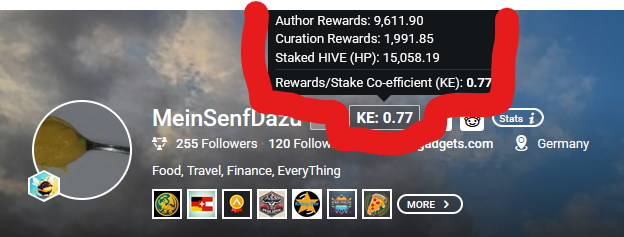EN (DE unten)
Hello dear community,
The KE coefficient, which can also be seen at Peakd, has been around for quite some time.
I hadn't looked into it in depth, but when I first heard about it, I decided after a moment's thought that it was bullshit. Even then, I thought to myself that it's a value that doesn't really say what it's supposed to say, what the intention behind it is.
I've come back to it now because @eddie-earner pointed out KE at @azircon.
Correct me if I'm wrong, but isn't this coefficient supposed to show how much someone is taking out of the Hive ÖK system, putting in, or keeping in?

This is calculated using the simple formula Rewards/Stake.
(Your author rewards + your curation rewards) / your stake = your KE
For me, it currently looks like this:

Since I have a value below 1, it means that I am staking more than I have received in rewards. At 1, it would be identical, and above 1, you would have a lower stake than the rewards you received.
If you don't look at the KE and think about what you can do to get a higher or lower KE, you might unfortunately think that those with <1 have put money into the Hive system and those with >1 have taken money out of the system.
Unfortunately, this interpretation is incorrect. Although the KE value is an objective value, it is not possible to interpret it based on this factor alone.
azircon writes:
"The goal of this post is to reflect personally on how I view
this simple quantitative metric to understand the general behavior of a hive user."
Unfortunately, however, the number does not reveal the behavior. Here are just two examples of probably many:
- There are users with multiple accounts. If users only post with account A and transfer from this account to account B and vote with it, then A has a value of probably significantly >1. However, the user has not taken anything out of the system.
- At the time of Hive ATH, a user had 10 K Hive and sold it for $30k and cashed out. Since the price is now 20 cents, he bought 10 K Hive for 2k euros. Now he has a KE of 1 again, but has taken $28K out of the Hive ecosystem.
These are just two examples, which of course also work the other way around.
There are, of course, other possibilities for taking money out of Hive and keeping your KE at 1 or below. I like to point out weaknesses, but I avoid revealing too much so that they cannot be exploited. That said, the KE is simply not important to me.
So what do you think, is it bullshit or am I wrong? Feel free to correct me if I'm wrong.
Translated with DeepL.com (free version)
DE
Hallo liebe Community,
schon etwas länger gibt es den KE-Coefficienten, der auch bei Peakd zu sehen ist.
Ich hatte mich nicht intensiv damit beschäftigt, aber schon als ich das erste Mal von gehört hatte, habe ich nach kurzem Überlegen für mich ausgemacht, es ist Bullshit. Denn schon da dachte ich mir, es ist ein Wert, der nicht wirklich das aussagt, was es aussagen soll, was die Intention dahinter ist.
Ich bin nun wieder dazu gekommen, weil @eddie-earner auf KE bei @azircon hingewiesen hat.
Korrigiert mich, aber eigentlich soll diese Coefficient einem zeigen, wieviel jemand aus dem Hiveöksystem zieht, hereinsteckt bzw. drin behält?

Dies wird durch die simple Formel Rewards/Stake errechnet.
(Deine Autor Rewards+ Deine Curration rewards )/ deinen Stake = Dein KE
Bei mir sieht das aktuell wie folgt aus:

Da ich einen Wert unter 1 habe, heißt es, dass ich mehr stake, als ich an Rewards erhalten habe. Bei 1 wäre es identisch und über 1 hätte man einen geringeren Stake als an Rewards, die man erhalten hat.
Wenn man sich nun nicht mit dem KE beschäftigt und sich überlegt, was man machen kann, um einen höheren oder niedrigeren KE zu bekommen, dann könnte man leider denken, wer <1 hat, hat Geld ins Hivesystem gesteckt und derjenige, der >1 hat, hat Geld aus dem System gezogen.
Leider ist diese Auslegung aber dann falsch. der KE Wert ist zwar ein objektiver Wert, aber die Auslegung allein auf diesen Faktor ist nicht möglich.
azircon schreibt:
"The goal of this post to do a personal reflection on how I am viewing
this simple quantitative metric to understand the general behavior of a hive user."
Leider kann man aber an der Zahl eben nicht das Verhalten ablesen, dafür hier nur 2 Beispiele von wohl etlichen:
- Es gibt User mit mehreren Accounts, wenn User nur mit einem Account A Posten und von diesem Account Hive auf den Account B transferieren und damit Voten, dann hat A einen Wert von wohl deutlich >1. Der Nutzer hat aber gar nichts aus dem System genommen.
- User hatte zu Hive ATH -Zeit 10 K Hive und hat diese für 30k $ verkauft und ausgecasht. Da der Kurs nun bei 20 Cent ist, hat er sich 10 K Hive für 2k Euro gekauft. Nun hat er dadurch wieder ein KE von 1, aber hat 28K $ aus dem Hiveökosystem herausgeholt.
Das sind nur 2 Beispiele, die natürlich auch genau andersherum funktionieren.
Es gibt natürlich noch weitere Möglichkeit, also Möglichkeiten was aus Hive herauszuholen und sein KE bei 1 oder darunter zu halten. Ich zeige gerne Schwachstellen auf, aber vermeide dann zu viel preis zu geben, damit es nicht ggf. ausgenutzt wird. Wobei mir eben der KE daher einfach nicht wichtig ist.
Also was meint ihr, ist es Bullshit oder liege ich falsch? Könnt mich gerne korrigieren, wenn ich falsch liege.
Downvoting a post can decrease pending rewards and make it less visible. Common reasons:
Submit